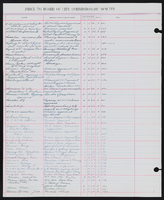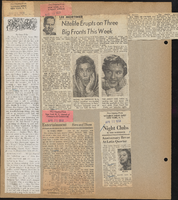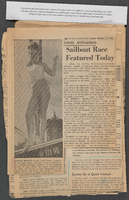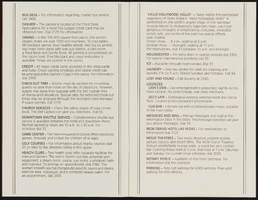Search the Special Collections and Archives Portal
Search Results
Fyhen, Ragnald, 1884-1971
Ragnald “Rags” Fyhen was an original member of the Nevada Central Labor Council. He was a labor organizer in the Clark County area. Fyhen was born in Tromso, Norway on August 1, 1884.
Fyhen was a machinist by trade. He came to Clark County in 1934 to work on the Hoover Dam and founded the Central Labor Council with some colleagues, which was instrumental in negotiating the labor agreement with Six Companies, Inc. to complete the dam. He served as the secretary-treasurer for the Central Labor Council from 1934 to 1947.
Person
"Las Vegas: the American Way to Play" promotional video for Las Vegas
Date
Archival Collection
Description
Voiceover explains the varied and many amenities of visiting Las Vegas; including the new McCarran International Airport, clips of entertainment and nightlife, gambling, dining options, outdoor activities, local shopping malls (Meadows, Boulevard, Fashion Show); Wet 'n Wild water park; sports including boxing, golf, tennis, Thomas & Mack event opportunities, Laughlin, Nev.; the Las Vegas Convention Center and Cashman field center; discusses the monorail system under construction, and how Las Vegas is the premier convention and resort town. Original media U-matic S, color, aspect ratio 4 x 3, frame size 720 x 486. From the Production Company Audiovisual Collection (MS-00930) -- Digitized audiovisual material file.
Moving Image
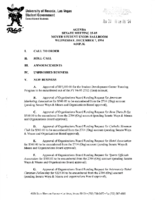
Meeting minutes for Consolidated Student Senate University of Nevada, Las Vegas, December 07, 1994
Date
Archival Collection
Description
Text
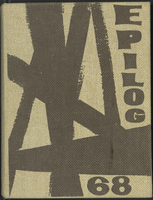
Epilogue: Nevada Southern University Yearbook, 1968
Date
Description
Yearbook main highlights: schools and departments; detailed lists with names and headshots of faculty, administration and students; variety of photos from activities, festivals, campus life, and buildings; campus organizations such as sororities, fraternities and councils; beauty contest winners; college sports and featured athletes; and printed advertisements of local businesses; Institution name: Nevada Southern University, Las Vegas, NV
Mixed Content

Photographs of Las Vegas Club signs, Las Vegas (Nev.), June 24, 2016
Date
Archival Collection
Description
Site name: Las Vegas Club (Las Vegas, Nev.)
Site address: 18 Fremont St
Sign owner: Las Vegas Club
Sign details: The Las Vegas Club originally opened on the opposite side of Fremont than it is today in the 1930's. It held one of the first few Neon signs on Fremont which was installed around ca.1930. In 1949 the Las Vegas Club reopened in its new location on Main and Fremont Street, and once held a large Baseball Hall of Fame. It has closed down in 2015 and demolition of the building began in 2017.
Sign condition: 4- Signage was working well and still had bright paint before the building had undergone demolition
Sign form: Pylon and architectural
Sign-specific description: They convey sports themes throughout their signs. There was a bronze-type sculptural baseball player. Large Neon and incandescent sign that wrapped around the whole building. Though above each entrance there is a plain graphic lettering with neon surrounding the letters.
Sign - type of display: Neon and Incandescent
Sign - media: Steel and bronze-type material (baseball player)
Sign - non-neon treatments: Sculptural element and incandescent
Sign animation: Flasher for incandescent
Sign environment: This location is on the north corner of Main and Fremont St. It is just north of the Golden Gate and across the street from the Plaza. It also had the Golden Goose, Glitter Gulch and Mermaids to the East of it.
Sign manufacturer: YESCO
Sign designer: Brian "Buzz" Lemming
Sign - date of installation: Circa 1960's
Sign - thematic influences: They convey sports/baseball themes within their signage which showcases the theme of their Baseball Hall of Fame.
Survey - research locations: Neon Museum Tour Hand book, Vintage Vegas http://vintagelasvegas.com/search/Las+Vegas+Club Images, Charles Barnard The Magic Sign.
Survey - research notes: The original Las Vegas Club in the 1930's had the tallest tallest sign in downtown Las Vegas until it was superseded by the Lucky Casino sign about a decade later.
Surveyor: Wyatt Currie-Diamond
Survey - date completed: 2017-09-02
Sign keywords: Architectural; Steel; Sculptural; Incandescent; Flashing; Neon; Bullnose
Mixed Content
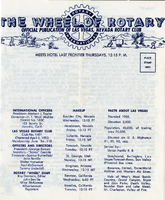
The Wheel of Rotary Las Vegas Rotary Club newsletter, December 23, 1954
Date
Archival Collection
Description
Text

